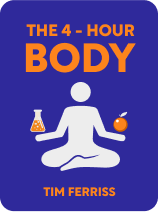

This article is an excerpt from the Shortform book guide to "The 4-Hour Body" by Timothy Ferriss. Shortform has the world's best summaries and analyses of books you should be reading.
Like this article? Sign up for a free trial here .
Do you know how to stick to a diet? Do you need tips for sticking to a diet from The 4-Hour Body?
The 4-Hour Body suggests using a slow-carb diet to get the results you want, but first, you have to know how to stick to a diet. Thankfully, Tim Ferriss has some tips for sticking to a diet that can help you troubleshoot if you’re struggling.
Read on for tips for sticking to a diet from The 4-Hour Body.
Troubleshooting and Tips for Sticking to a Diet
Following any diet is challenging. Here are some of the common problems people encounter with the Slow-Carb Diet and how to stick to a diet when you face these issues:
Problem #1: You feel the diet is too strict. If you think the diet is too hard to commit to upfront, try the following tips for sticking to a diet:
- Committing to only a one-week test.
- Starting by only changing breakfast. Once you see results, you’ll be more motivated to fully commit.
- Planning to eat forbidden foods on cheat day.
- Trying sugar-free Jell-O in dark moments.
Problem #2: You don’t like some of the diet’s specific requirements. You can tweak the diet as follows:
- If you want to flavor your coffee, use less than two tablespoons of cream instead of milk.
- If you want the meals to have more flavor, use spices, herbs, and sauces (but not cream-based sauces). The author recommends salsa, Montreal steak rub, or macadamia oil, to name a few.
- If you have dietary restrictions, adjust. For example, if you’re vegetarian, don’t eat the meat and eat more legumes instead.
- If you don’t like beans, you can eat other legumes instead, or manipulate the beans to mitigate some of their unpopular effects:
- To avoid getting gassy after eating beans, soak them in water before cooking them, buy canned beans, or add Beano or epazote to the beans. These methods break down the carbohydrate that causes flatulence.
- To make beans taste less bland, add seasonings such as hot sauce, garlic powder, or balsamic vinegar.
- To improve the texture, make the beans into “mashed potatoes” by cooking the beans in olive oil, adding some water, and seasoning like mashed potatoes.
Problem #3: You think repeating meals is boring. Remember that the results are worth a little boredom. Also, reflect on how you used to eat—probably, you often repeated meals anyway. Most people eat the same few breakfasts.
Problem #4: You have concerns about cooked vs. raw food. While there have been studies that show raw food is healthier than cooked food, the most-oft cited study was conducted on cats, who have two important biological distinctions from humans: 1) humans are omnivores and cats are carnivores, and 2) cats become unhealthy when they eat cooked food because heat deactivates taurine, an amino acid that helps digestion. Humans, on the other hand, can produce their own taurine so it’s not dangerous to eat cooked food. It’s fine to eat cooked kidney beans, carrots, and kale, among many other things. These tips for sticking to a diet help you take a more practical approach.
Problem #5: You’re not getting enough electrolytes. (Symptoms of this include feeling weak or experiencing spasms.) As you lose excess water on the diet, you lose electrolytes—such as calcium, magnesium, and potassium—as well. Calcium and magnesium are easiest to take as pills, though you can get them from food if you prefer. A high source of calcium is salmon with bones, and there’s a lot of magnesium in pumpkin seeds. You can get potassium from potassium-enriched salt, avocados, or pills.
Problem #6: You get hungry (or hunger creates low-blood sugar symptoms such as headaches). If you’re hungry, eat more legumes and protein at each meal. If you’re really hungry, eat an extra meal. If hunger keeps you up at night, have some protein before bed, such as a tablespoon of almond butter.
Problem #7: You want snacks. Since you should never be hungry on the diet, you likely want snacks for a psychological reason such as using them to procrastinate. If you have to snack, eat carrots.
Problem #8: You like eating out, or you’re traveling and have less control over what you eat. When you eat out, choose Mexican or Thai cuisine, which typically have a lot of the characteristics of the slow-food diet and are inexpensive. At any restaurant, ask for substitutions to get the food closer to your ideal meal (for example, sub in a salad for rice). If you don’t have a lot of options, eat walnuts or almonds. Likewise, you can find a chicken salad almost anywhere.
Problem #9: Menstruation (if applicable) is affecting your weight. Ignore your weight in the 10 days before you menstruate because you retain water during this time, which will skew the numbers. Start paying attention to weight again the day after your period ends.
Problem #10: You hit a plateau. Over time, your pace of fat loss will slow. Once this happens, you can introduce exercise.
Troubleshooting
There are several common questions and problems associated with moving to a PPBD. These tips for sticking to a diet can help you handle these issues.
Problem #1: You don’t know where to get your protein. Eat whole foods that contain a lot of protein, such as nuts, or plant-based protein powder, such as rice or pea protein. Avoid soy, because while it’s a source of protein, it can cause thyroid problems, and it contains estrogen, which in large amounts can cause sterility. Also, avoid dairy—in large quantities, it can cause health problems because store-bought products often contain antibiotics and hormones, which are bad for you.
Problem #2: You’re not getting enough nutrients. If you’re eating a PPBD, you won’t get the same nutrients as if you were eating animal products. In particular, make sure you get the USRDA recommended doses of vitamins D, B-12, and K, and biotin, lysine, and iodine by either using supplements or carefully planning what you eat. If you’re planning to get all your nutrients from food, consider consulting a nutritionist.
Problem #3: You like eating out, or you’re traveling and have less control over what you eat. Just like the Slow-Carb Diet, eat Mexican and Thai cuisine because both include veggies and beans. You can also eat raw nuts, which are available in most airports and will keep you full for a long time.
Additional Strategies and Tips for Sticking to a Diet
No matter which diet you use, you have to stick with it to see recomp changes. However, humans are inherently bad at making permanent lifestyle changes. Fortunately, there are five tips for sticking to a diet to help you stay on track:
Strategy #1: Prioritize. The first strategy is to pick and choose between the four strategies below. You only need to change the minimum amount that will create results. Choose two of the four strategies marked with an asterisk (*) to get started.
Strategy #2: Be aware of your behavior as it happens. It’s less useful to become aware of actions after they’ve occurred because there’s no way to change them. For example, reflect on what you’re eating before you eat it. Specifically:
- *Photograph your food. Take photos of all your meals and snacks for 3-5 days and include your hand in the photos for scale. Put the photos somewhere public, such as online, so you know that other people know what you’re eating. This will force you to reflect on your choices.
- *Use before and after photos. Take a photo of yourself in your swimsuit or underwear and place the photo in a prominent location where you’ll come across it often, such as on your fridge. Every time you see it, you’ll be reminded of what you’re trying to change and be less inclined to self-sabotage by making bad dietary choices.
Strategy #3: *Motivate yourself by taking measurements. Measure and track your body fat percentage, total inches, and any additional measurements you’re interested in. Once you hit five entries, you’re likely to become hooked.
- For example, people can track their runs on the Nike+ site. People who track more than five runs are more likely to keep on tracking.
Strategy #4: Harness the power of competition. Adding an element of game or competition to your diet motivates you to change your behavior so you can “win” the game. Interestingly, humans are more motivated by failure than success—scientists have discovered that people are more distraught about losing $50 than winning $50—so use negative stakes in particular, such as humiliation, for motivation. Specifically:
- *Start a competition with someone. Compete with someone to see who can most decrease their TI, body fat, or as a last resort, weight.
- Increase the stakes of a competition by betting on the outcome.
- For example, Ramit bet his entire contact list that in 90 days, he could gain 15 pounds of muscle. He trash-talked to make it even more humiliating if he lost. He quickly met his goal.
- Make the competition public. For example, post about it on social media. You’ll work harder when you think someone’s watching you.
- Employ social comparison theory, which states that in a group, you’ll be better than some people and worse than others. Compare yourself to the people below you to feel good about yourself, and compete with those above you—if they can do it, you can too.
Strategy #5: Don’t try to change multiple lifestyle factors all at the same time because you’ll get overwhelmed.
- For example, if you don’t cook, eat frozen or canned food so you don’t have to both diet and learn to cook at the same time.

———End of Preview———
Like what you just read? Read the rest of the world's best book summary and analysis of Timothy Ferriss's "The 4-Hour Body" at Shortform .
Here's what you'll find in our full The 4-Hour Body summary :
- How to do the least amount you need to do for the results you want
- Why you need a cheat day in your diet
- How to improve everything about your body, including sleep, sex, and longevity






